- Info
The NoLiMit project
Non-linear Bayesian partition modeling of the Earth's mantle transition zone
H2020 Marie Skłodowska-Curie Actions
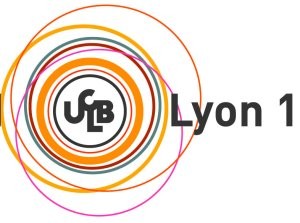 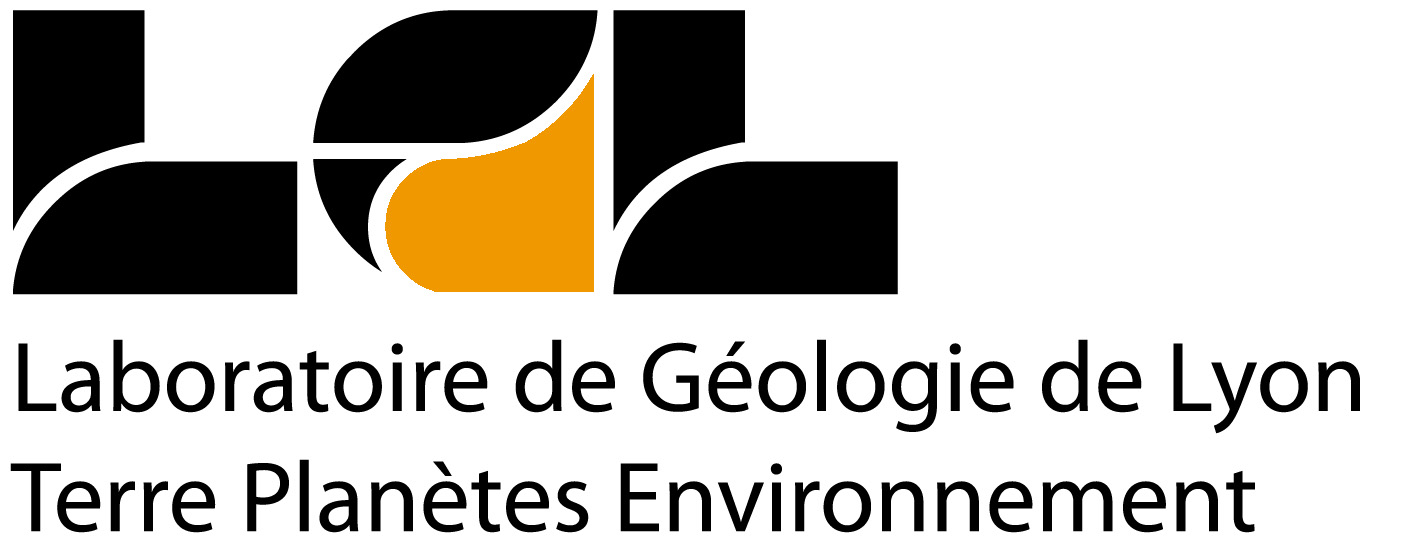  
Summary
The Earth’s mantle transition zone is a complex region exhibiting mineralogical phase changes as revealed by sharp increases of seismic wave-speed between 410 and 660 km depths. Because of its potential in filtering chemical elements, the transition zone represents a key region for understanding how efficient is global mantle convection to mix and recycle geochemical heterogeneities. Global sampling of the transition zone is only possible with seismic methods, via the analysis of seismic waves generated by large, distant earthquakes and subsequently recorded by receivers located on the Earth’s surface. These waves propagate and illuminate the Earth’s deep internal interior, and provide critical constraints on the elastic structure. Seismologists and geophysicists have since the 90’s attempted to isolate the effects of temperature and composition on mantle elastic properties. However, a major issue is imperfect seismic data coverage that prevents from reconstructing the multiple length-scales of thermo-chemical heterogeneities. Seismic and laboratory-based data suffer also from large uncertainties, and the relationship between seismic observables and in situ thermo-chemical parameters remains questionable. To overcome these limitations, this project will use a partitioning (multi-scale) approach to isolate the effects of mantle temperature and composition on the most comprehensive databases of seismic waves sensitive to the transition zone. Using a Bayesian probabilistic framework, I will simulate with their uncertainties the multi-scale physical properties of the transition zone, confront the results with high-pressure mineral physics experiments and with predictions from mantle convective mixing models. The interdisciplinary approach of this project relies on using state-of-the-art numerical methods and high performance computing to answer fundamental questions in Earth Sciences, seismology, geodynamics, and mineral physics. The uniqueness of the approach arises from quantifying in a probabilistic sense how conceptual mantle-mixing models explain seismic data. The outcomes of the project will be to provide new databases, procedures, models, and software packages for the analysis and understanding of the Earth's upper mantle structure.
Seismic probes and the transition zone
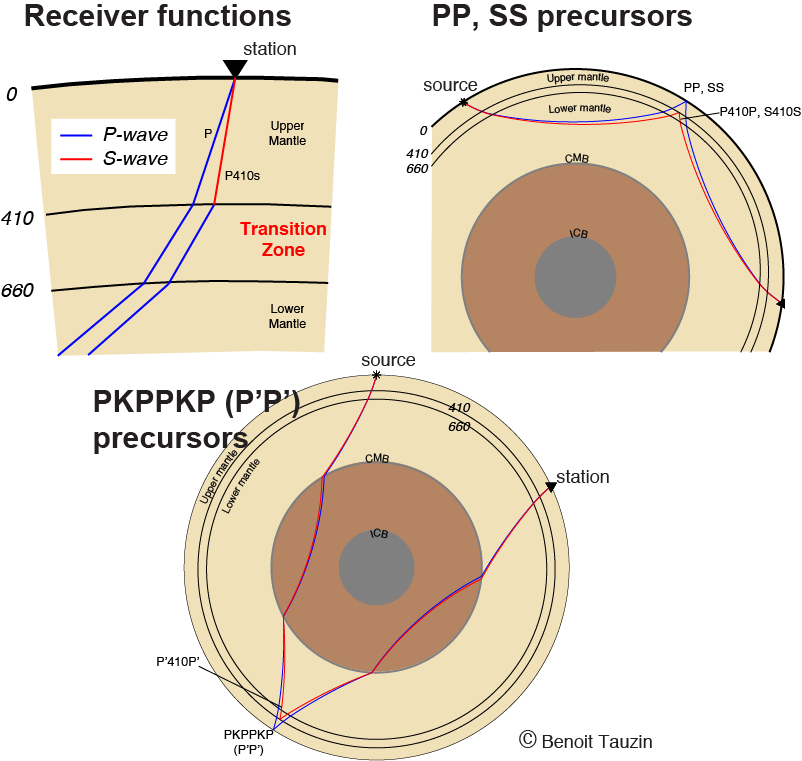
|
To probe the deep upper mantle, seismologists use various types of seismic waves that interact with the two boundaries atop
and at the bottom of the transition zone.
I show the ray-paths of such waves between one earthquake source and one seismological station
in the figure at left.
The game is to identify on seismograms the arrivals associated with:
- (top left) the conversions of P-wave into S-wave
at interfaces beneath the station, also called receiver functions.
- (top right and bottom) P or S-wave reflections underneath interfaces
reflected half-way between the source and station and recorded as precursors of the PP, SS, or PKPPKP (P'P') phases.
The PKPPKP phase is a wave traveling four times through the mantle and two times through the outer core of the Earth, and reflected almost at the antipode of the couple source-station.
These probes are standard in the seismological community. They are complementary as they provide different resolution and coverage of the transition zone.
During the course of my career, I have built for such probes large databases of hundreds of thousands of seismic waveforms. Handling such type of data requires good skills in signal processing, data archiving, programming, and — the most primordial — data mining.
My databases cover the mantle globally or regionally with high-resolution by benefiting from the dense coverage in seismic stations. Because of the distribution of sources and stations, the coverage is not perfect, though.
I work also with Lauren Waszek who build the most up-to-date databases presently.
|
Data Download
- Observations in northeast Asia of the 410 and 660-km discontinuity topography from P-to-S receiver functions at dense regional networks and from global SdS data (Tauzin et al., JGR, 2018).
- Regional observations of low-velocity zones atop the 410-km and 660-km discontinuities beneath northeast China (Tauzin et al., EPSL, 2017).
- Regional observations of a low-velocity zone atop the 410-km discontinuity beneath the western US (Tauzin et al., JGR, 2013) are here.
- The global P-to-S receiver functions measurements from Tauzin et al. JGR (2008) can be downloaded here.
- A comprehensive view of the global database of P-to-S receiver functions built during my PhD (Tauzin et al, JGR, 2008) can be found here.
References
- Tauzin, B., Kim, S., & Afonso, J. C. (2018). Multiple phase changes in the mantle transition zone beneath northeast Asia: Constraints from teleseismic reflected and converted body waves. Journal of Geophysical Research: Solid Earth, 123(8), 6636-6657.
- Tauzin, B., Kim, S., & Kennett, B. L. N. (2017). Pervasive seismic low-velocity zones within stagnant plates in the mantle transition zone: Thermal or compositional origin?. Earth and Planetary Science Letters, 477, 1-13.
- Tauzin, B., Van Der Hilst, R. D., Wittlinger, G., & Ricard, Y. (2013). Multiple transition zone seismic discontinuities and low velocity layers below western United States. Journal of Geophysical Research: Solid Earth, 118(5), 2307-2322.
- Tauzin, B. (2009). Apport des techniques de fonctions récepteur Ps et de phases précurseurs de SS à l'imagerie du manteau supérieur (Doctoral dissertation, Strasbourg).
- Tauzin, B., Debayle, E., & Wittlinger, G. (2008). The mantle transition zone as seen by global Pds phases: no clear evidence for a thin transition zone beneath hotspots. Journal of Geophysical Research: Solid Earth, 113(B8).
|
P-wave coda correlations / The receiver function method
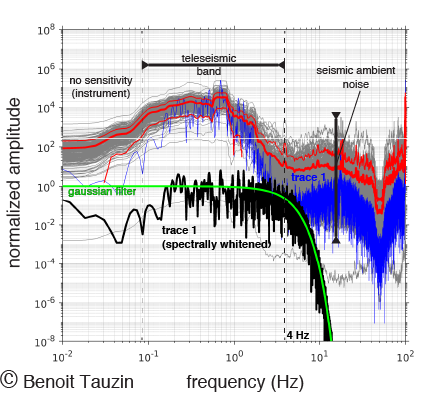
|
The receiver function method consists in applying a signal processing operation — a deconvolution — to remove the signature of seismic sources from three-component seismological records, and demodulate the signal from the structure (see left, for insiders!).
Since the work of Charles Langston and many others, this method is well-documented in the context of extracting converted waves beneath seismic stations. Here is a good introduction that I recommand to my students.
This method has also the potential for extracting waves reflected multiple times in the stratification beneath the receivers (also called multiple reverberations or "multiples").
At the Research School of Earth Science at ANU, I had the opportunity to investigate the connections between the receiver function method and principles of seismic interferometry, more recently used in ambient noise correlation techniques.
This lead to the Matlab code available below (Tauzin et al., GJI, 2019).
The main benefits of this research are:
- The developped method makes use of single recording components of stations.
- It allows extracting information on the P-wave velocity structure (contrary to classical receiver functions).
- The method is less sensitive to the nature and magnitude of the sources.
|
The code
- Download the Matlab code from Tauzin et al. GJI (2019) here.
References
- Tauzin, B., Pham, T. S., & Tkalčić, H. (2019). Receiver functions from seismic interferometry: a practical guide. Geophysical Journal International, 217(1), 1-24.
- Tauzin, B., Bodin, T., Debayle, E., Perrillat, J. P., & Reynard, B. (2016). Multi-mode conversion imaging of the subducted Gorda and Juan de Fuca plates below the North American continent. Earth and Planetary Science Letters, 440, 135-146.
Imaging seismic discontinuities
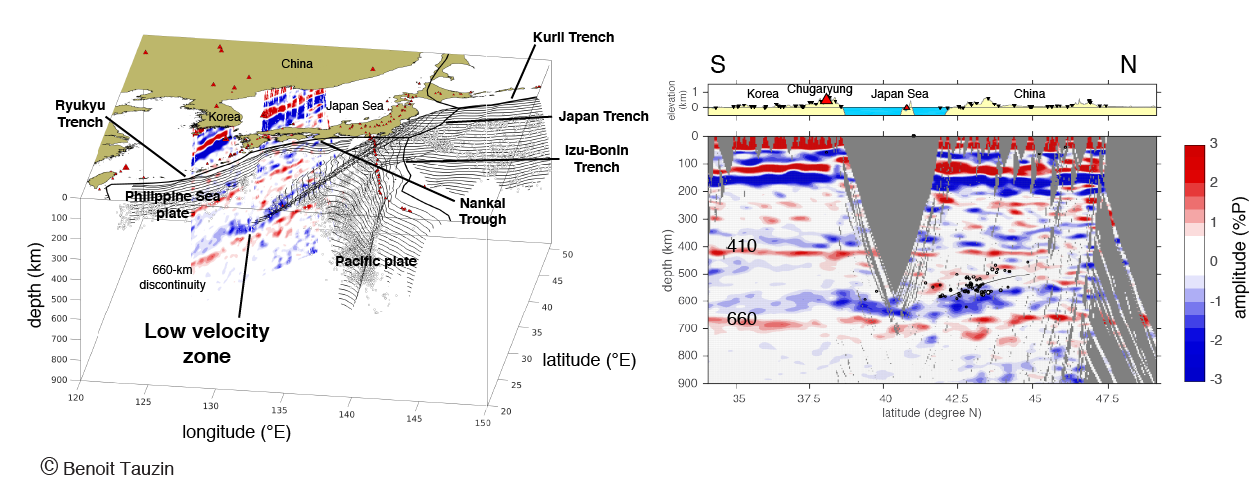
|
The goal is to image "sharp" discontinuities in seismic wave-speed between 410 and 660 km depths, and put constraints
on their depths and the way they reflect/convert seismic energy.
These discontinuities are likely controled by mineralogical phase changes. The mineral lattices restructure in response to differing pressure-temperature conditions.
Therefore, knowing the depth (pressure) at which occur seismic wave conversions/reflections is of primary importance for constraining the temperature in the mantle.
The amplitude of reflections/conversions informs on the shape of the velocity profile: Is the velocity increasing or decreasing with depth? Over which depth interval occur the phase changes? |
These observations can then be interpreted with the help of mineral physicists (such as my colleague from Lyon University Jean-Philippe Perrillat) who crush tiny rock samples into huge presses and
measure the properties of rocks at high-pressure.
I have dedicated a large part of my career in tracking apparent low-velocity zones within or surrounding the transition zone. A spectacular example is given in the above figure, for northeast Asia, where such a zone (in blue) seems to delineate the base of the subducted Pacific plate beneath Japan and the Eurasian continent (Tauzin et al., EPSL, 2017).
Similar zones can be found in active zones of northwest America and Europe, too (e.g. Tauzin et al. Nature Geo., 2010; Tauzin et al., JGR, 2013; 2018; Hier-Majumder and Tauzin, EPSL, 2017).
The reason why these zones focus much attention is that they hardly represent a pure thermal anomaly. Do they mark compositional heterogeneity, i.e. volatile elements and partial melting? In that case, is this evidence for a mechanism of filtering and/or recycling of geochemical heterogeneities?
Recently with my colleagues from Chungnam University (South Korea), Seongryong Kim, and Macquarie University Sydney, Juan Carlos Afonso, we proposed that solid-state phase changes in a homogeneous mantle could provide an alternative mechanism for forming some of these low-velocity zones (Tauzin et al., JGR, 2018).
References
- Tauzin, B., Kim, S., & Afonso, J. C. (2018). Multiple phase changes in the mantle transition zone beneath northeast Asia: Constraints from teleseismic reflected and converted body waves. Journal of Geophysical Research: Solid Earth, 123(8), 6636-6657.
- Tauzin, B., Kim, S., & Kennett, B. L. N. (2017). Pervasive seismic low-velocity zones within stagnant plates in the mantle transition zone: Thermal or compositional origin?. Earth and Planetary Science Letters, 477, 1-13.
- Hier-Majumder, S., & Tauzin, B. (2017). Pervasive upper mantle melting beneath the western US. Earth and Planetary Science Letters, 463, 25-35.
- Tauzin, B., Van Der Hilst, R. D., Wittlinger, G., & Ricard, Y. (2013). Multiple transition zone seismic discontinuities and low velocity layers below western United States. Journal of Geophysical Research: Solid Earth, 118(5), 2307-2322.
- Tauzin, B., Debayle, E., & Wittlinger, G. (2010). Seismic evidence for a global low-velocity layer within the Earth’s upper mantle. Nature Geoscience, 3(10), 718.
The scale matters
The global seismic structure of the transition zone is robustly constrained only down to a wavelength of ~2600 km. However, models obtained from dense seismic networks reveal features spanning smaller spatial scales of a hundred kilometers.
Present global reconstructions use artificially coarse model parameterizations to account for the variable spatial sensitivity of the data, often resulting in a poor resolution of these small-scale features.
With the help of Malcolm Sambridge and Hrvoje Tkalcic at ANU, Thomas Bodin and Rhys Hawkins at Université de Lyon, I design software modules to better account for the multiple spatial scales in the seismic structure and the imperfect data coverage.
These modules rely on partitions of the Earth such as shown in the figure at right.
The present version of the algorithm finds an optimal parameterization based on the standard errors in the data.
The scheme works at regional scale for observations of receiver functions with dense networks (figure at right), and on global datasets of receiver functions, SS and PP-precursors.
|
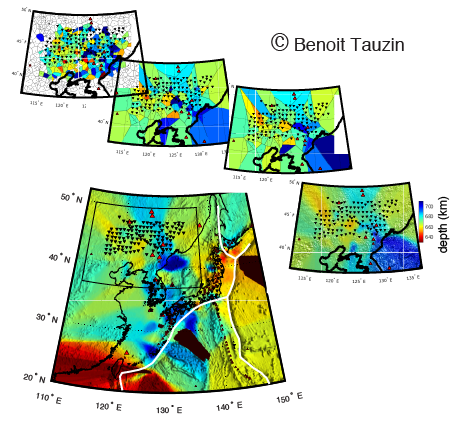
|
Software packages
- Adaptive stacking code for global and regional datasets will be soon released here.
- Gaussian Mixture Modeling code for picking complex interfaces will soon be released here.
- Bayesian partition modeling code for regional datasets will soon be released here.
References
- Waszek, L., Tauzin, B., Schmerr, N., Ballmer, M. (2018, December). Global observability of the 410 and 660 km discontinuities: implications for mantle mineralogy. In AGU Fall Meeting Abstracts.
- Tauzin, B., Afonso, J. C., Sambridge, M., Tkalcic, H., Kim, S., & Bodin, T. (2017, April). Towards a fully probabilistic reconstruction of the elastic, thermal and petrological structure of the Earth's mantle transition zone. In EGU General Assembly Conference Abstracts (Vol. 19, p. 5855).
Rocks, minerals, and seismic properties
Effective elastic properties of mantle rocks are influenced by multiple physical parameters (temperature, pressure, and composition).
An important parameter is the presence or not of a small fraction of partial melt that potentially generates large reductions of shear-wavespeed.
With my colleague from the Royal Holloway University of London, Saswata Hier-Majumder, we modeled the elastic properties of bi-phasic mantle aggregates to explore the effect of melt volume fraction, wetting angle, and geometry (Hier-Majumder and Tauzin, EPSL, 2017).
We applied this approach to infer that roughly 0.5 vol% of melt could explain observations of a low-velocity zone on top of the transition zone in the western US.
This type of analysis is important for closing the budget in volatile elements (CO2, H2O), one component being cycled through the mantle.
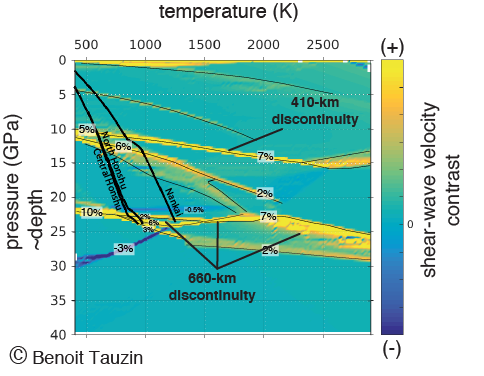
|
More generally, the better knowledge of rock physical properties at elevated pressure and temperature improves our predictions for the elastic structure of the upper mantle.
With the help of Juan Carlos Afonso from Macquarie University Sydney, we work at predicting the effect of mineralogical phase changes on seismic waveforms for the various probes cited above.
We found that the effects are a lot more complex than usually described, with multiple gradients and discontinuities (figure at left).
For instance, transitions associated with the silica component (SiO2) may lead to sharp reductions of velocities at the base of the transition zone, potentially explaining observations of low-velocity zones (Tauzin et al., JGR, 2018).
With my colleague from New Mexico University, Lauren Waszek, we also found that the complex gradients may explain the transparency of the 660-km discontinuity when using PP-precursors reflected data (Waszek et al., AGU, 2018)
|
Laboratory experiments are quite important to understand what are the main controling parameters on mineralogical phase changes, and their effects on seismic properties.
My colleague from Lyon University, Jean-Philippe Perrillat, triggers phase changes in tiny rock samples at very high pressure (~13 GPa).
He monitors at high-precision with ultra-sound sensors the evolution of elastic properties across the phase changes.
He finds a peculiar behavior with a weakening of the mantle material related to the "meta-stability" of the low-pressure phase across the transition (i.e. non-equilibrium thermodynamics).
|
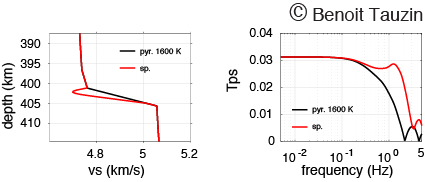
|
We work at modeling such an effect on seismic observables in terms of reflectivity and attenuation (Perrillat et al. AGU, 2017; Tauzin et al. EGU, 2018).
This might solve a long-standing debate on the sharpness of transition zone discontinuities.
References
- Perrillat, J. P., Chantel, J., Tauzin, B., Jonfal, J., Daniel, I., Jing, Z., & Wang, Y. (2017, December). Acoustic Velocities Across the Olivine-Wadsleyite-Ringwoodite Transitions and the Seismic Signature of the 410 km Mantle Discontinuity. In AGU Fall Meeting Abstracts.
- Tauzin, B., Perrillat, J. P., Bodin, T., Manthilake, G., & Hier-Majumder, S. (2018). Constraints on thin layers with high-attenuation and low-velocities in the mantle. In EGU General Assembly Conference Abstracts (Vol. 20, p. 5855).
- Waszek, L., Tauzin, B., Schmerr, N., Ballmer, M. (2018, December). Global observability of the 410 and 660 km discontinuities: implications for mantle mineralogy. In AGU Fall Meeting Abstracts.
- Tauzin, B., Kim, S., & Afonso, J. C. (2018). Multiple phase changes in the mantle transition zone beneath northeast Asia: Constraints from teleseismic reflected and converted body waves. Journal of Geophysical Research: Solid Earth, 123(8), 6636-6657.
- Hier-Majumder, S., & Tauzin, B. (2017). Pervasive upper mantle melting beneath the western US. Earth and Planetary Science Letters, 463, 25-35.
Geodynamics
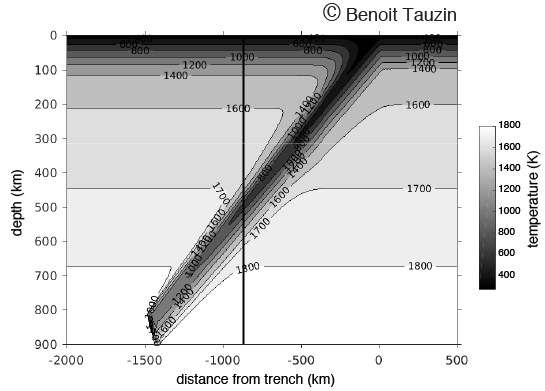
|
A driving mechanism for plate tectonics is mantle convection, where Earth's solid silicate rocks slowly deform and flow in cold downgoing currents (the plates), and in hot upwelling currents (the plumes).
We have a good knowledge of where locate these cold and hot currents in the Earth's mantle.
Mineralogical phase changes are often seen as reliable thermometers. Yet their exploration and interpretation in terms of temperature often lead to a complex jigsaw puzzle.
To better understand the first-order effects of temperature on regional scale transition zone elastic structure, me and my colleague Juan Carlos Afonso develop a finite-element algorithm to solve heat transfer equations and predict thermal fields for realistic geodynamical scenarios.
By combining the thermal field and mineral physics data, we hope to provide a better description of the local complexity of velocity gradients associated with mineralogical phase changes.
|
References
- Tauzin, B., Kim, S., & Afonso, J. C. (2018). Multiple phase changes in the mantle transition zone beneath northeast Asia: Constraints from teleseismic reflected and converted body waves. Journal of Geophysical Research: Solid Earth, 123(8), 6636-6657.
- Tauzin, B., Kim, S., & Kennett, B. L. N. (2017). Pervasive seismic low-velocity zones within stagnant plates in the mantle transition zone: Thermal or compositional origin?. Earth and Planetary Science Letters, 477, 1-13.
Seismic modeling
Seismic modeling is the operation of predicting what would be the seismic record of an earthquake given an Earth's model described in terms of elastic properties (vp, vs and density).
Many different algorithms exist for that, with all their intrinsic approximations or range of applicability.
Seismic modeling for investigating the structure of the transition zone is challenging because:
- We have to model multiple portions of the seismogram for extracting P-to-S conversions, PP, or SS- precursors.
- This modeling must be done at high-frequency (sometimes, up to 1 Hz),
- and at teleseismic distances, i.e. for a long-range wave-propagation between the source and a receiver located at a distance larger than 10,000 km.
- This modeling must be done for thousands of earthquakes.
The consequence is that the choice of the algorithm is driven by considerations of computational efficiency:
- A plane-wave matrix algorithm enables us to look at the high-frequency effect on reflection coefficients of the shape of velocity gradients.
- A reflectivity algorithm can be used to model the full seismic waveform at larger cost and lower frequency.
- 2D/3D finite-difference algorithms allows testing the effect on waveforms of complex laterally-variable structures.
|
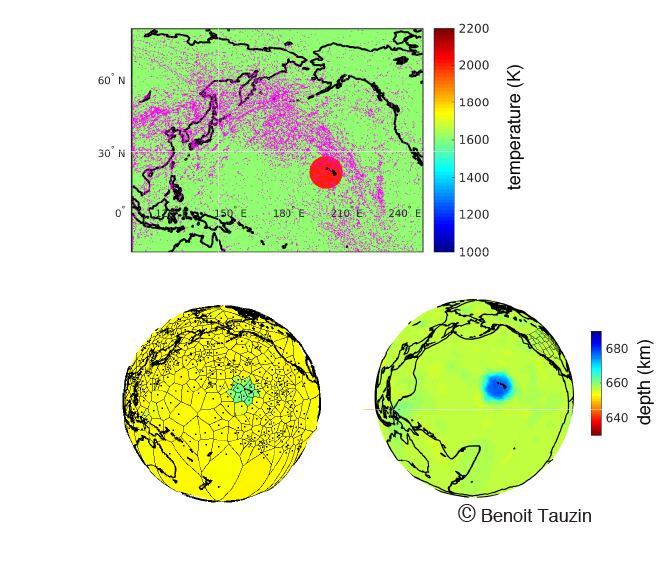
|
I have developped a method for accounting for the variable source mechanisms, avoiding the need for simulating wave-propagation for each earthquake in the databases.
I am now able to predict P-to-S receiver functions, PP-, and SS-precursors waveforms for a mantle thermal field and compositional model, and check the consistency of the seismic imaging with the input thermal field/structure (e.g. figure above)
Despite strong approximations, it is now possible to test first-order features of the seismic data.
The inverse approach
The inverse problem is trying to infer what is the model or family of models that best explain seismic observations.
A typical approach is to "invert" seismic waveforms for the elastic structure, in which case the forward problem used to predict waveforms is one of the seismic modeling approaches cited above.
Here, with my colleague Amir Khan from ETH Zurich, we have adopted a different approach which is coupling the predictions of elastic properties from mineral physics to an algorithm of seismic wave propagation.
The forward problem then allows to predict (with plenty of assumptions) seismic waveforms directly from mantle temperature and composition.
We then apply an optimization algorithm, as well as Bayesian statistical inference, to find the thermo-chemical models that best fit seismic waveforms.
We are still at a preliminary phase, where the inversion works technically and we apply the approach at global scale on a few tens of seismic stations. Preliminary results are interesting.

This work is achieved by a PhD student from ETH Zurich, Federico Munch.
He obtained an Outstanding Student Presentation Award for his poster at the AGU Fall Meeting 2018.
The inversion scheme has presently been developed for fitting P-to-S receiver function waveforms, but we are currently developping joint inversions with:
- Observations of surface-wave dispersion up to the 5th overtone.
- S-to-P receiver functions.
References
- Munch, F. D., Khan, A., Tauzin, B., Zunino, A., & Giardini, D. (2018). Stochastic Inversion of P‐to‐S Converted Waves for Mantle Composition and Thermal Structure: Methodology and Application. Journal of Geophysical Research: Solid Earth, 123(12), 10,706-10,726.
- Munch, F. D., Khan, A., Tauzin, B., & Giardini, D. (2018, December). Stochastic inversion of P-to-S converted waves for mantle thermal and compositional structure. In AGU Fall Meeting Abstracts. DI41B-0012.
Université de Lyon, LGL, TPE,
Benoit Tauzin Home page. Seismology,
mantle transition zone, converted waves,
SS precursors, hotspot, subduction.
Université de Lyon, LGL, TPE,
Benoit Tauzin Home page. Seismology,
mantle transition zone, converted waves,
SS precursors, hotspot, subduction.
Université de Lyon, LGL, TPE,
Benoit Tauzin Home page. Seismology,
mantle transition zone, converted waves,
SS precursors, hotspot, subduction.
Université de Lyon, LGL, TPE,
Benoit Tauzin Home page. Seismology,
mantle transition zone, converted waves,
SS precursors, hotspot, subduction.
|
Personal tools














